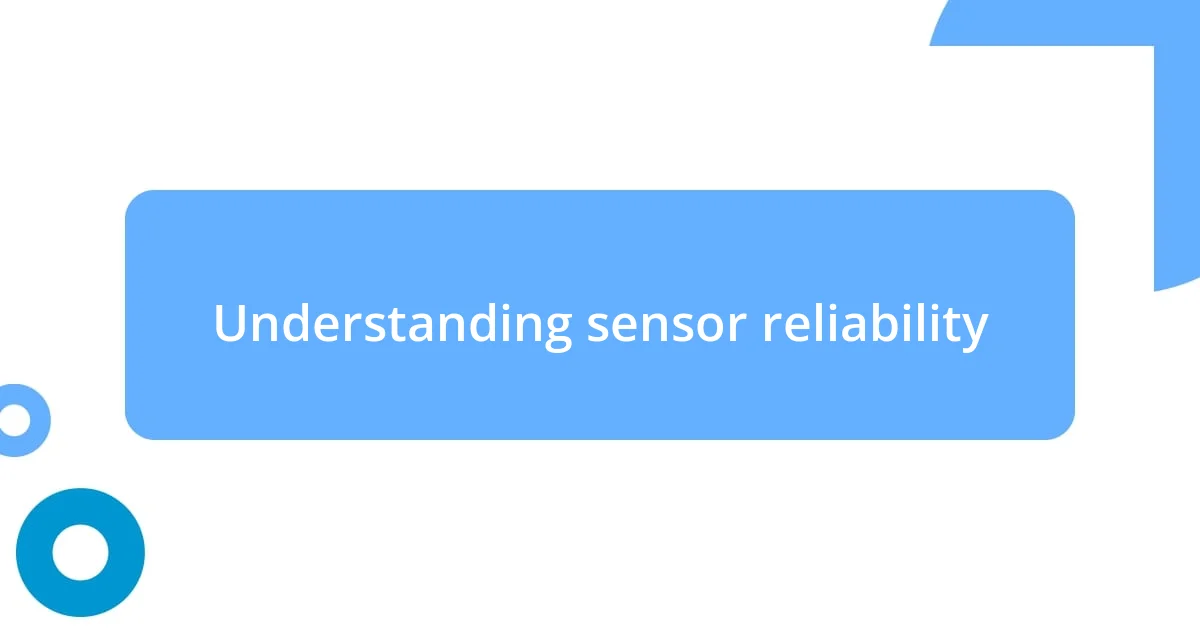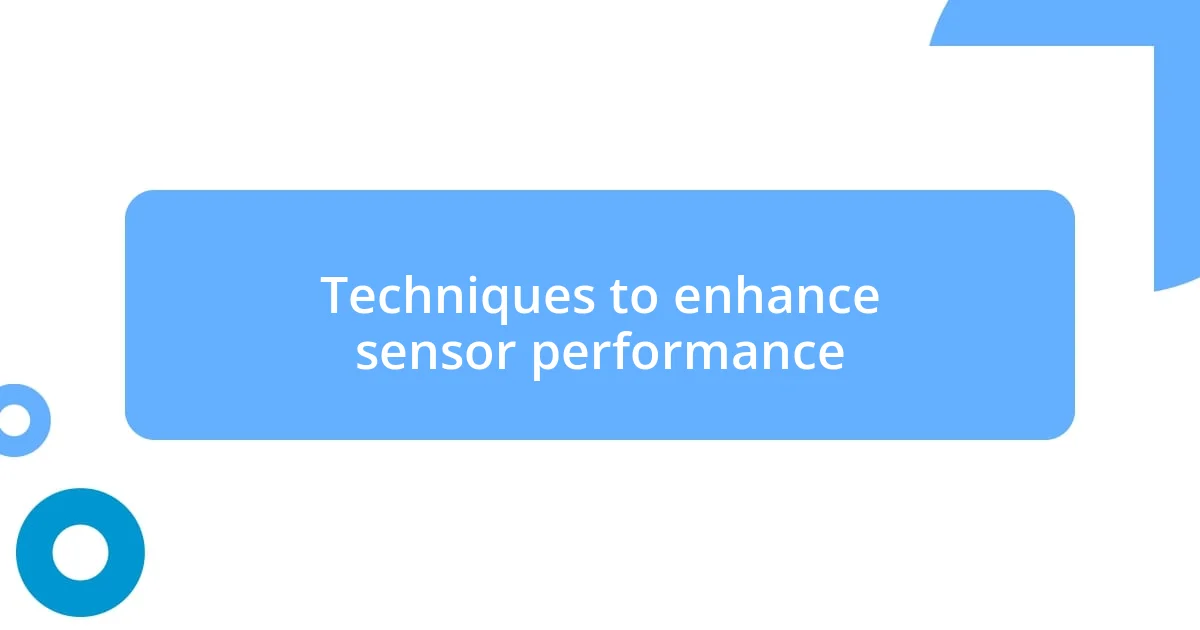Key takeaways:
- Understanding sensor reliability involves acknowledging factors like environmental conditions, wear, and the importance of calibration and maintenance for long-term accuracy.
- Enhancing sensor performance can be achieved through proper shielding, implementing redundancy, and keeping software updated.
- Feedback loops from users are crucial for continuous improvement, guiding refinements in sensor designs and maintenance processes, ultimately enhancing overall reliability.

Understanding sensor reliability
Sensor reliability is fundamentally about the accuracy and consistency of data these devices deliver. I recall a time when a temperature sensor in a climate control system failed, causing significant fluctuations that led to production losses. Have you ever experienced a scenario where sensor inaccuracy led to unexpected problems? It can be incredibly frustrating.
When I think about reliability, I often consider the various factors that impact a sensor’s performance over time, such as environmental conditions and wear and tear. It’s not just about how they function initially but also about their long-term durability. For instance, in one of my projects, we had to replace sensors more often than anticipated because we hadn’t fully accounted for humidity effects — a mistake I won’t make again.
Another critical aspect of understanding sensor reliability is the importance of calibration and maintenance. I learned this the hard way after neglecting regular checks on a vital pressure sensor in a manufacturing process. The results? Inconsistent readings that cost time and resources. It makes me wonder—how often do we take a moment to assess the reliability of our tools? Investing time in regular monitoring can save us from more significant headaches down the line.

Factors affecting sensor reliability
When considering the reliability of sensors, several factors come into play. I’ve seen firsthand how environmental conditions can wreak havoc on performance. For example, during a project near coastlines, salty air played a detrimental role in sensor corrosion, leading to early failures. It’s a sobering reminder that surroundings can be as critical as the technology itself.
Here’s a quick overview of the main factors affecting sensor reliability:
- Environmental Conditions: Temperature extremes, humidity, and exposure to corrosive substances can degrade sensors over time.
- Mechanical Stress: Vibration and physical impacts can misalign or damage sensor components, causing measurement errors.
- Calibrations and Adjustments: Regular calibration is essential to ensure sensors provide accurate readings; neglect can lead to compounding errors.
- Aging and Wear: Over time, components naturally wear down, which affects performance, making routine checks vital for long-term reliability.
These influences, I’ve learned, are interwoven with the life cycle of the sensor, providing a comprehensive picture of what truly affects performance.

Techniques to enhance sensor performance
When it comes to enhancing sensor performance, I’ve found that implementing proper shielding can make a world of difference. For example, in one project where sensors were exposed to electromagnetic interference, adding appropriate enclosures significantly improved data accuracy. It’s fascinating how something as simple as physical protection can mitigate external disruptions.
Another technique that has proven beneficial is employing redundancy in sensor systems. I remember an industrial application where we installed multiple temperature sensors in critical areas. This not only offered a safety net—if one sensor failed, the others took over—but it also highlighted discrepancies that led us to recalibrate the overall system. Have you ever thought about how backups can enhance not just reliability, but also your peace of mind?
Lastly, regular software updates play a crucial role in sensor performance enhancement. I experienced this firsthand when outdated firmware caused erratic readings in a key pressure sensor. Once we implemented a routine update schedule, the improvements in stability and accuracy were evident. It’s amazing how keeping software current is just as essential as the hardware itself.
| Technique | Description |
|---|---|
| Proper Shielding | Using enclosures to protect sensors from environmental interferences. |
| Redundancy | Installing multiple sensors to ensure continuous data integrity. |
| Regular Software Updates | Keeping firmware current to avoid issues and enhance performance. |

Regular calibration and maintenance
Regular calibration and maintenance of sensors is often the unsung hero in ensuring their reliability. I remember a time on a project where we had a temperature sensor mislabeled in terms of accuracy—only to discover, after months of use, that it hadn’t been calibrated since installation. The feeling of realizing that our data was off all this time was frustrating. It really drives home how essential it is to treat calibration not just as a checklist item, but as an ongoing commitment to maintaining accuracy.
During my early years in the field, I witnessed the profound impact of routine maintenance firsthand. There was an incident where neglected humidity sensors in a production facility led to unexpected product spoilage. It wasn’t just a financial hit; it was quite emotional seeing the team’s hard work undermined by something we could have easily prevented. That experience taught me that consistent maintenance checks are not just about preserving hardware—they are about protecting the integrity of your entire operation.
In my experience, I’ve found that setting a regular schedule for calibrating and maintaining sensors can be a game-changer. Have you ever considered how easy it is to dismiss those routine checks? Yet, when I adopted a structured approach, I noticed a marked difference in system performance. Sensors that once fluctuated wildly started providing data that was not just reliable, but truly reflective of real-time conditions. That clarity brought not just confidence in the data, but also enhanced trust among the team. Isn’t that what we all want—information we can trust, without second-guessing?

Using quality materials and components
When I think about using quality materials and components, I can’t help but recall a project involving a series of moisture sensors. Initially, we opted for cost-effective components, but after facing constant failures, we decided to switch to higher-grade materials. The difference was astounding; not only did the sensors perform reliably, but they also had a longer lifespan, reducing our long-term costs significantly. Isn’t it amusing how penny-pinching in the short term often bites us later?
In another instance, I was tasked with upgrading the sensors for a temperature-sensitive project. I chose sensors with robust casings designed specifically to withstand harsh environments. The result was a marked reduction in erroneous readings, and the team’s morale soared. After feeling the frustration of previous faulty data, we celebrated these improvements as a team. It’s those moments that remind me how investing in quality can transform not just technology, but also the human experience behind it.
Reflecting on different projects, I firmly believe that using quality materials is like laying a solid foundation for a building. If the foundation isn’t strong, the entire structure is at risk of collapsing. Have you ever encountered an unreliable sensor that led to costly mistakes? I know I have, and it reinforced my commitment to selecting only the best components upfront. It’s all about creating an environment where reliability thrives, and by choosing quality, we pave the way for long-lasting success in our sensor systems.

Testing methods for reliability assurance
Testing methods play a pivotal role in assuring sensor reliability. I remember one project where we implemented extensive environmental testing to simulate real-world conditions. It was eye-opening to see how sensors reacted to temperature fluctuations and humidity changes, highlighting weaknesses we hadn’t anticipated. Hasn’t it ever struck you how much you can learn about your systems just by putting them through the wringer? Such tests can prevent future catastrophes in data collection.
Another approach I’ve found useful is accelerated life testing, where sensors are subjected to extreme conditions over a shorter timeline. During a critical project, I witnessed the immediate benefits of this method as it revealed potential failure points long before we rolled out the sensors. Seeing those insights come to life was exhilarating; it sparked conversations and collaborative problem-solving sessions that ultimately strengthened our designs. Have you ever experienced that thrill of discovering a key issue before it becomes a real problem? It’s a rush that reinforces the value of thorough testing.
Then there’s field testing, which is my favorite—there’s nothing like observing sensors in action. On one occasion, we deployed a batch of sensors in a remote location, monitoring environmental data in real-time. I felt a mix of anxiety and excitement, knowing that our reliability depended on those devices functioning flawlessly in challenging conditions. When the first week passed with all sensors reporting accurately, I breathed a sigh of relief. It reminded me that every test is not just a number, but a testimony to our commitment to dependable technology. Isn’t that reassurance priceless?

Implementing feedback loops for improvement
Implementing feedback loops is essential for continuous improvement in sensor reliability. In my experience, incorporating real-time data and user feedback transformed how we approached design flaws. For instance, after rolling out a new sensor series, we established direct communication channels with end-users to gain insights about their experiences. Their feedback offered unexpected perspectives, guiding us to refine the calibration processes, which ultimately enhanced accuracy and user satisfaction.
As I reflect on a specific instance, I remember how a simple survey revealed persistent issues with a certain product. By analyzing the responses, we identified that regular errors stemmed from environmental conditions not accounted for during development. This moment was profound; it reaffirmed that our users were invaluable partners in the improvement process. Have you ever thought about how those on the front lines often notice what designers overlook? Creating those feedback loops not only validates our efforts but also fosters a sense of community between us and our users.
Looking back, I appreciate how establishing regular review sessions helped us assess the feedback systematically. During one such session, we introduced changes that significantly reduced failure rates within just a few weeks. I recall feeling a mixture of pride and relief when we reviewed results showcasing the impact of our collective adjustments—it’s one thing to send products into the field, but another entirely to watch them thrive due to collaboration. Isn’t it exhilarating to see how feedback transforms challenges into stepping stones for success?













